Gennaro Cuofano's Blog, page 90
November 7, 2022
How to identify a business opportunity [A useful framework from The Opportunity Lenses]
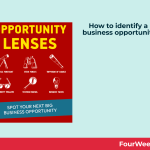
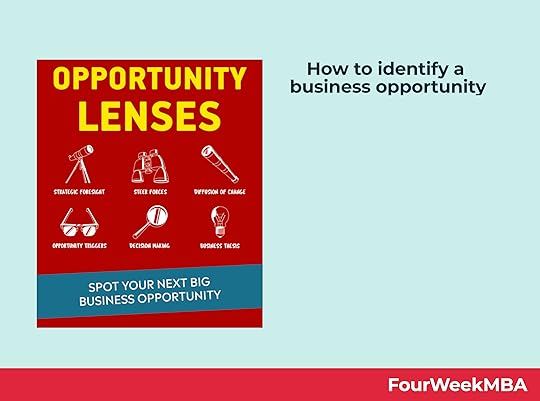
Identifying new business opportunities is critical to any company. A business opportunity is at the core of any business model.
In this article, I have the pleasure to interview Guerric de Ternay who will tell us more about how to identify new business opportunities.
I already invited Guerric in FourWeekMBA to talk about hacking value proposition design.
Guerric runs innovation projects at ?What If!, a global consultancy part of Accenture. And he is the author of two books about strategic innovation.
I wanted to have Guerric back to talk about his latest book: The Opportunity Lenses.
Enjoy the interview!
Last time we spoke, you had just published The Value Mix . Why did you want to write another book?The business world gained a lot from frameworks such as the lean startup and customer development. But I felt that we were missing tools that could help us identify what opportunities we should pursue.
Indeed, the lean startup assumes that you already have an idea for your business. What happens if you don’t?
I still remember meeting with Eric Ries a few years ago. Eric was doing a book tour in London. I asked him: “Eric, the principle of build-test-learn is so helpful. But what can you do if you don’t have an idea yet?” Eric simply said that you first need to find an idea. While he had popularised a terrific innovation framework to the world, he didn’t really have an answer to that question.
This moment stuck with me.
The business world now knows how to iterate and improve ideas to get to product-market fit. But how do we find this business opportunity that we want to go after?
My answer to this is The Opportunity Lenses.
So, what can we do to get better at finding opportunities?First, it is a mindset to adopt. You must be constantly searching for opportunities. Be curious. Observe what’s happening in the market and how things are changing. The more you open your eyes, the better you’ll get at identifying opportunities.
Second, you must acknowledge that there are a lot of bad opportunities. A LOT!
It’s okay to find opportunities that will lead you nowhere. Sometimes, it’s because there’s not enough market momentum. Sometimes, it’s because there’s already a big competitor. Sometimes, it’s because it’s not possible to make it profitable.
Just keep going!
The more you’re attuned to spotting opportunities, the more likely you’ll find your next big opportunity.
Do you have any tools to help identify those business opportunities?I do! Actually, The Opportunity Lenses is packed with tools. It’s what pushed me to pick the book title. “Lenses” refers to all the different tools that are presented in the book.
One of the things I recommend is to take the long view and observe the big macro trends that are shaping our world. What are their implications? How are they changing our lives?
For example, we’ve seen the ongoing growth of the creator economy. There are several macro trends that are pushing it. Among them: Direct access to an audience via social media, the willingness of people to be more independent in their work, and the improvement of technology to create high-quality media. It creates many opportunities to cater for the growing group of creators. There are so many angles to do this: content creation, monetisation, accounting, or admin support.
Here’s another example: We know that people are becoming more health conscious. They have better access to general health recommendations. Wearables (such as glucose monitors) give real-time feedback on how our nutrition affects our body. What could you do here? It could be worth exploring no-sugar alternatives, supplements and fortified food, or veggie-based meals.
As you progress on the path of identifying business opportunities, you may want to zoom in. You could look at a specific part of the population. How do these changes affect parents and how they feed their kids? What about people who do outdoor sports? Or people are constantly on the go?
There are so many trends out there, is there a way to make sense of them?
I use a tool that I called STEER. By breaking down the macro-trends into 5 different buckets, you can understand more easily what is causing an opportunity to emerge and creating momentum for it.
The acronym STEER stands for Socio-cultural, Technological, Economic, Environmental, and Reglementary. These five categories are the main long-term drivers of opportunities.
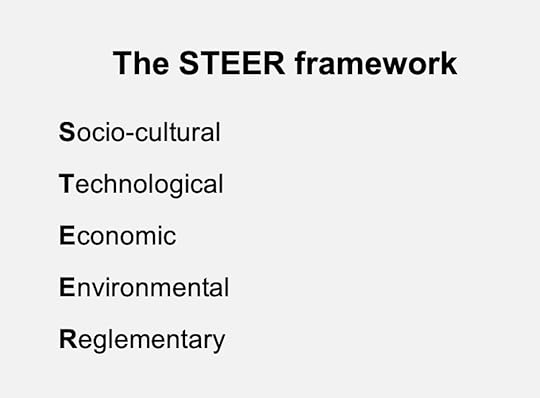
As we’ve seen in the previous examples, new technologies can trigger new opportunities. As wearables become more popular, it’s likely that we’ll see new businesses emerging from that. Not only hardware businesses, but also insurances, doctor’s practices, coaching services, and software companies.
Socio-cultural trends are also very powerful. The fact that we are becoming more health conscious creates massive shifts in the consumer goods industry. New healthy brands are emerging every day, and the incumbents are also pivoting towards healthier products. Look at PepsiCo divesting Tropicana (the widely known orange juice brand) to focus on water and zero-calorie beverages. They understand the shift.
There are many ways to identify new business opportunities. A good start is to look at macro-trends through the lens of the STEER framework.
You’ve published two books. Do you have any advice for our readers who would like to write a business book?Writing a book must be treated like designing any product. First, you should make sure that there’s an opportunity here. Why does it make sense to write a book about topic X ou Y?
Here’s an example: Rob Fitzpatrick who wrote The Mom Test had spotted a great opportunity. The customer development approach pioneered by Steve Blank was gaining a lot of traction among tech entrepreneurs. But there wasn’t a clear guide to tell you how to approach interviewing your customers. The Mom Test filled this gap successfully.
You need to make sure that your book is useful. What does that mean? Be clear on the outcome that the reader expects when they pick up your book. If they buy a book about making sushi, the outcome they expect is a great sushi night that they host. On top of sharing sushi recipes, could you also give advice on how to host your friends and eat sushi in a real Japanese way?
Business books are the same. They must deliver an outcome to their readers.
In my case, I wanted to help my readers to identify business opportunities, so they can start their own company with strong foundations. The book is also useful for people who work in a company to help them think about new opportunities for that company.
On top of that, I realised that a lot of consultants read business books to learn new tools and frameworks that they can reuse with their clients. With The Opportunity Lenses, I want innovation consultants to be better equipped to give clearer recommendations to their clients.
The business book industry is highly competitive. There are so many books that are being published every year. But if you’re very precise on what outcome your audience is hoping for, and if you have a useful solution for them, you can make it a big success.
Final thoughts?If you know someone who’s considering starting a business or who has recently started one, suggest having a look at The Opportunity Lenses.
They’ll be grateful for your recommendation. 
Read Next: Hacking Value Proposition Design
The post How to identify a business opportunity [A useful framework from The Opportunity Lenses] appeared first on FourWeekMBA.
Communication Types
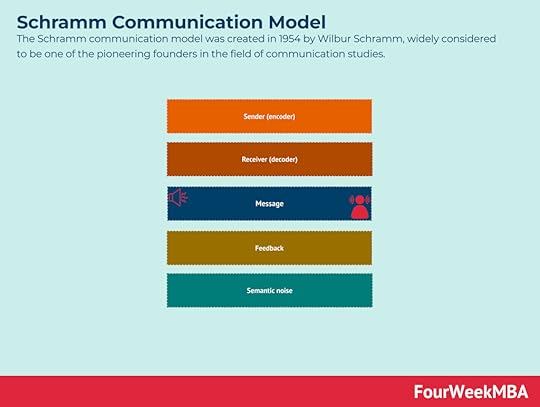 The Schramm communication model was created in 1954 by Wilbur Schramm, widely considered to be one of the pioneering founders in the field of communication studies.
Noise in Communication
The Schramm communication model was created in 1954 by Wilbur Schramm, widely considered to be one of the pioneering founders in the field of communication studies.
Noise in Communication
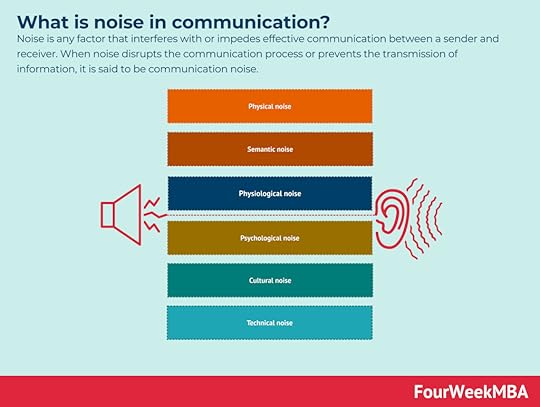 Noise is any factor that interferes with or impedes effective communication between a sender and receiver. When noise disrupts the communication process or prevents the transmission of information, it is said to be communication noise.
Helical Model of Communication
Noise is any factor that interferes with or impedes effective communication between a sender and receiver. When noise disrupts the communication process or prevents the transmission of information, it is said to be communication noise.
Helical Model of Communication
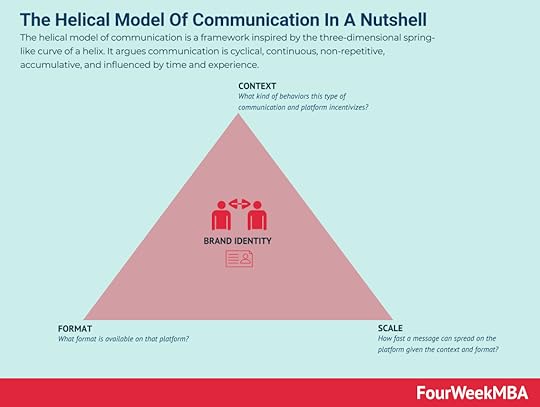 The helical model of communication is a framework inspired by the three-dimensional spring-like curve of a helix. It argues communication is cyclical, continuous, non-repetitive, accumulative, and influenced by time and experience.
Integrated Marketing Communication
The helical model of communication is a framework inspired by the three-dimensional spring-like curve of a helix. It argues communication is cyclical, continuous, non-repetitive, accumulative, and influenced by time and experience.
Integrated Marketing Communication
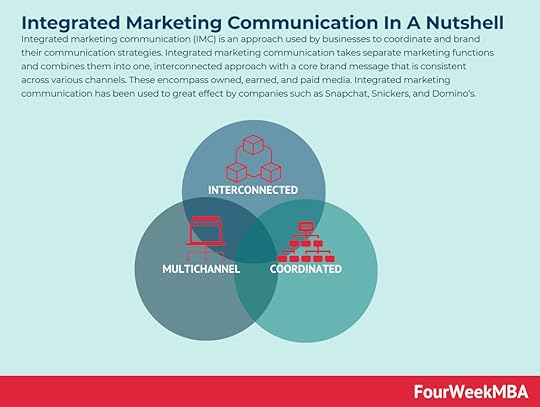 Integrated marketing communication (IMC) is an approach used by businesses to coordinate and brand their communication strategies. Integrated marketing communication takes separate marketing functions and combines them into one, interconnected approach with a core brand message that is consistent across various channels. These encompass owned, earned, and paid media. Integrated marketing communication has been used to great effect by companies such as Snapchat, Snickers, and Domino’s.
Social Penetration Theory
Integrated marketing communication (IMC) is an approach used by businesses to coordinate and brand their communication strategies. Integrated marketing communication takes separate marketing functions and combines them into one, interconnected approach with a core brand message that is consistent across various channels. These encompass owned, earned, and paid media. Integrated marketing communication has been used to great effect by companies such as Snapchat, Snickers, and Domino’s.
Social Penetration Theory
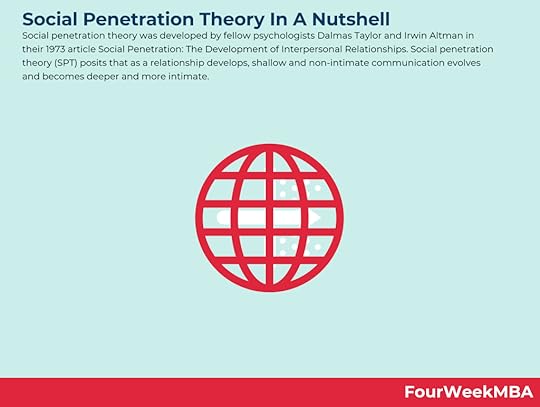 Social penetration theory was developed by fellow psychologists Dalmas Taylor and Irwin Altman in their 1973 article Social Penetration: The Development of Interpersonal Relationships. Social penetration theory (SPT) posits that as a relationship develops, shallow and non-intimate communication evolves and becomes deeper and more intimate.
Hypodermic Needle Theory
Social penetration theory was developed by fellow psychologists Dalmas Taylor and Irwin Altman in their 1973 article Social Penetration: The Development of Interpersonal Relationships. Social penetration theory (SPT) posits that as a relationship develops, shallow and non-intimate communication evolves and becomes deeper and more intimate.
Hypodermic Needle Theory
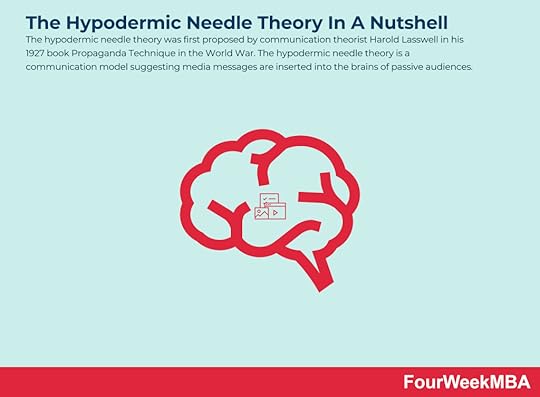 The hypodermic needle theory was first proposed by communication theorist Harold Lasswell in his 1927 book Propaganda Technique in the World War. The hypodermic needle theory is a communication model suggesting media messages are inserted into the brains of passive audiences.
Aristotle’s Model of Communication
The hypodermic needle theory was first proposed by communication theorist Harold Lasswell in his 1927 book Propaganda Technique in the World War. The hypodermic needle theory is a communication model suggesting media messages are inserted into the brains of passive audiences.
Aristotle’s Model of Communication
 The Aristotle model of communication is a linear model with a focus on public speaking. The Aristotle model of communication was developed by Greek philosopher and orator Aristotle, who proposed the linear model to demonstrate the importance of the speaker and their audience during communication.
Transactional Model of Communication
The Aristotle model of communication is a linear model with a focus on public speaking. The Aristotle model of communication was developed by Greek philosopher and orator Aristotle, who proposed the linear model to demonstrate the importance of the speaker and their audience during communication.
Transactional Model of Communication
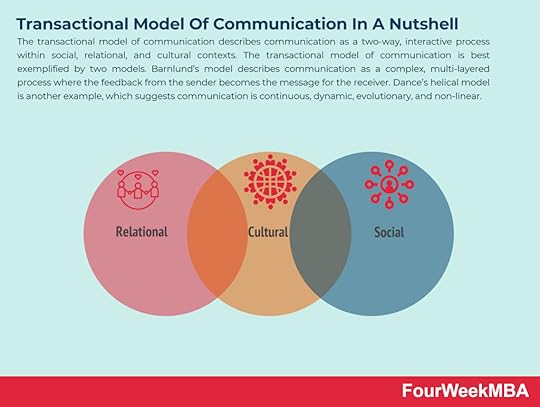 The transactional model of communication describes communication as a two-way, interactive process within social, relational, and cultural contexts. The transactional model of communication is best exemplified by two models. Barnlund’s model describes communication as a complex, multi-layered process where the feedback from the sender becomes the message for the receiver. Dance’s helical model is another example, which suggests communication is continuous, dynamic, evolutionary, and non-linear.
Communication Cycle
The transactional model of communication describes communication as a two-way, interactive process within social, relational, and cultural contexts. The transactional model of communication is best exemplified by two models. Barnlund’s model describes communication as a complex, multi-layered process where the feedback from the sender becomes the message for the receiver. Dance’s helical model is another example, which suggests communication is continuous, dynamic, evolutionary, and non-linear.
Communication Cycle
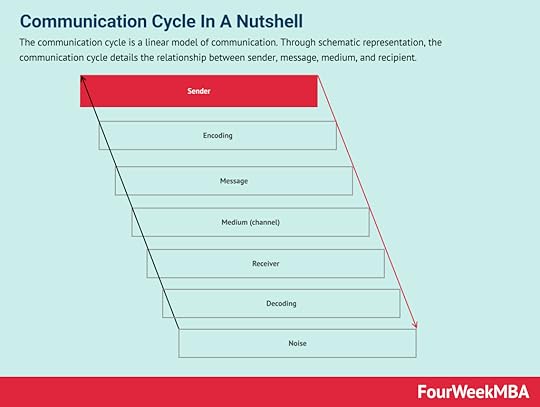 The linear model of communication is a relatively simplistic model envisaging a process in which a sender encodes and transmits a message that is received and decoded by a recipient. The linear model of communication suggests communication moves in one direction only. The sender transmits a message to the receiver, but the receiver does not transmit a response or provide feedback to the sender.
Uncertainty Reduction Theory
The linear model of communication is a relatively simplistic model envisaging a process in which a sender encodes and transmits a message that is received and decoded by a recipient. The linear model of communication suggests communication moves in one direction only. The sender transmits a message to the receiver, but the receiver does not transmit a response or provide feedback to the sender.
Uncertainty Reduction Theory
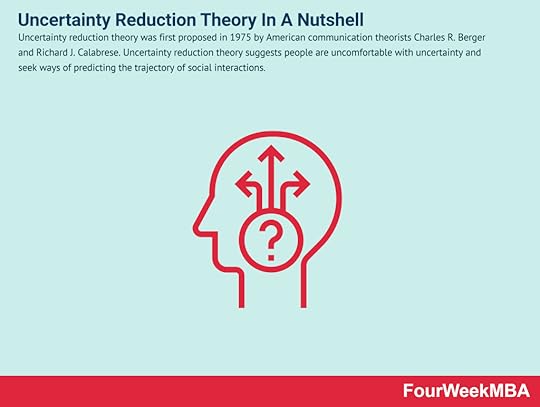 Uncertainty reduction theory was first proposed in 1975 by American communication theorists Charles R. Berger and Richard J. Calabrese. Uncertainty reduction theory suggests people are uncomfortable with uncertainty and seek ways of predicting the trajectory of social interactions.
Berlo’s SMCR Model
Uncertainty reduction theory was first proposed in 1975 by American communication theorists Charles R. Berger and Richard J. Calabrese. Uncertainty reduction theory suggests people are uncomfortable with uncertainty and seek ways of predicting the trajectory of social interactions.
Berlo’s SMCR Model
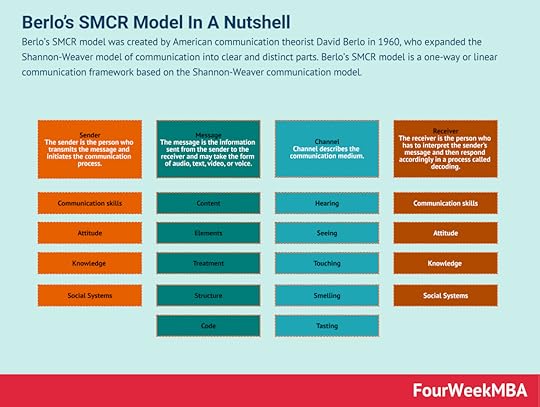 Berlo’s SMCR model was created by American communication theorist David Berlo in 1960, who expanded the Shannon-Weaver model of communication into clear and distinct parts. Berlo’s SMCR model is a one-way or linear communication framework based on the Shannon-Weaver communication model.
Lasswell Communication Model
Berlo’s SMCR model was created by American communication theorist David Berlo in 1960, who expanded the Shannon-Weaver model of communication into clear and distinct parts. Berlo’s SMCR model is a one-way or linear communication framework based on the Shannon-Weaver communication model.
Lasswell Communication Model
 The Lasswell communication model is a linear framework for explaining the communication process through segmentation. Lasswell proposed media propaganda performs three social functions: surveillance, correlation, transmission. Lasswell believed the media could impact what viewers believed about the information presented.
The Lasswell communication model is a linear framework for explaining the communication process through segmentation. Lasswell proposed media propaganda performs three social functions: surveillance, correlation, transmission. Lasswell believed the media could impact what viewers believed about the information presented. The post Communication Types appeared first on FourWeekMBA.
October 18, 2022
Slack Mission Statement Analysis
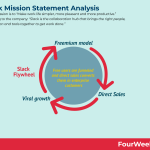
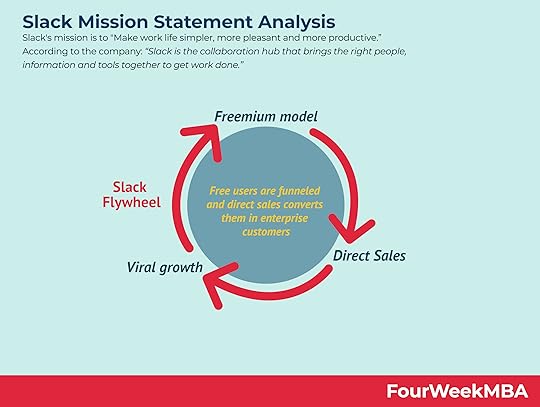
Slack’s mission is to “Make work life simpler, more pleasant and more productive.” According to the company: “Slack is the collaboration hub that brings the right people, information and tools together to get work done.”
Slack Mission Statement AnalysisLet’s take the rest of this article to deconstruct Slack’s mission statement with specific reference to how the company’s messaging platform makes work:
More simple, More pleasant, And more productive. SimplicitySlack facilitates instant and uninterrupted communication between subordinates, colleagues, and superiors.
Individuals can use Slack to easily contact others – irrespective of whether they are colleagues or employed by another company.
They can also work collaboratively in channels where emojis simplify communication and “mentions” attract the attention of the right people.
Within these channels, users can also share audio or video clips containing important project information.
The file itself is attached to the conversation to provide context for all participants, and information can be accessed regardless of one’s location, function, or time zone.
PleasantnessPleasantness is a little difficult to define, but here are two features we believe Slack’s mission statement and make work more enjoyable for its customers:
Slack huddlesThese are utilized by teams to easily reach consensus via assessment of available options.
Huddles are audio-centric and intend to replicate the fast, informal, team discussions that occur in a traditional office.
Slack also noted that for employees, huddles were a much-needed alternative to back-to-back video calls.
Scheduled sendThis feature enables users to delay the sending of important messages to a more convenient time for the recipient.
Using scheduled send, teams can communicate more effectively and empathetically with others.
ProductivityProductivity is demonstrated by Slack’s platform which unites over 2,500 apps and enables teams to streamline communications and automate manual processes.
This means Slack customers have more time to focus on the creative aspects of their work.
Slack Connect is the primary way productivity is enhanced on the platform. Conversations with partners, vendors, and customers can be moved from siloed email threads to a more efficient collaboration interface.
This approach results in impressive benefits to Slack Connect users, with the company claiming that the service increases the speed of the deal cycle for sales teams by 400% and reduces backlog tickets for customer support by 64%.
The productivity of Slack’s mission statement is also supported by:
The ability to build and connect new workflows across organizations and share, streamline, or simplify routine tasks.Robust client relationships in channels that provide top-tier enterprise support and decrease response times, andEnterprise-grade security features and compliance standards that reduce inefficiencies related to spam attacks and email phishing.Key takeaways:Slack’s mission statement is to “Make work life simpler, more pleasant and more productive.” According to the company’s website, “Slack is the collaboration hub that brings the right people, information and tools together to get work done.”Slack facilitates instant and uninterrupted communication between subordinates, colleagues, and superiors. Files containing important information are attached to conversations to provide context and are accessible to all participants regardless of function or location.The pleasantness of the Slack platform is enhanced by a feature that provides a welcome alternative to back-to-back video calls. Slack Connect, on the other hand, is the primary way productivity is enhanced on the platform.Read Next: Slack Business Model
Read: Mission Statement Examples.
Mission Statement Case Studies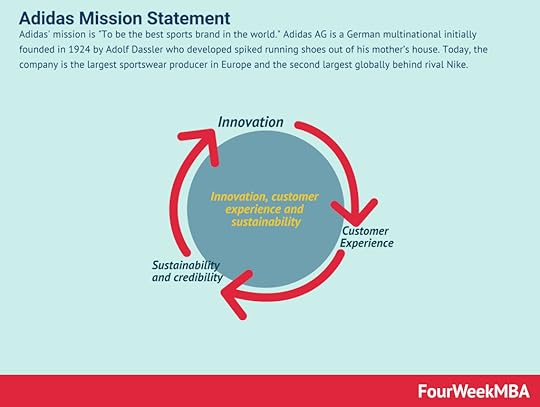 Adidas’ mission is “To be the best sports brand in the world.” Adidas AG is a German multinational initially founded in 1924 by Adolf Dassler who developed spiked running shoes out of his mother’s house. Today, the company is the largest sportswear producer in Europe and the second largest globally behind rival Nike.
Adidas’ mission is “To be the best sports brand in the world.” Adidas AG is a German multinational initially founded in 1924 by Adolf Dassler who developed spiked running shoes out of his mother’s house. Today, the company is the largest sportswear producer in Europe and the second largest globally behind rival Nike.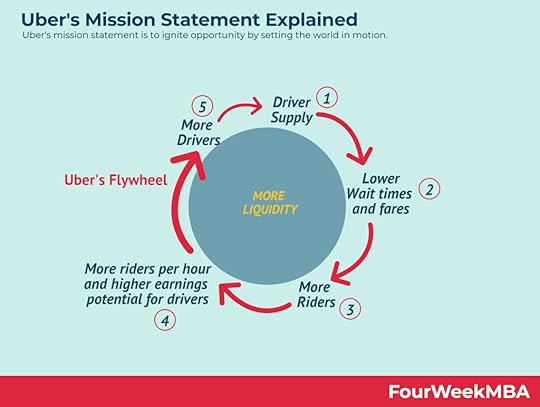 Uber’s mission statement is to ignite opportunity by setting the world in motion.
Uber’s mission statement is to ignite opportunity by setting the world in motion.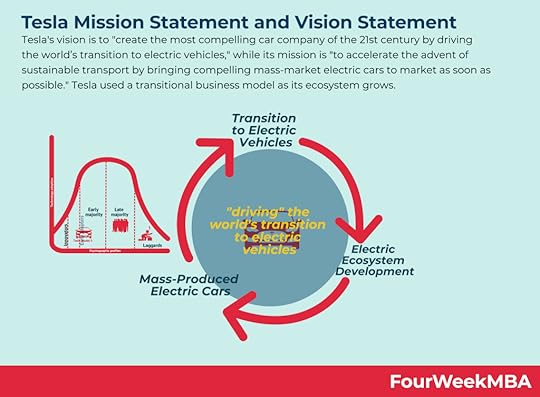 Tesla’s vision is to “create the most compelling car company of the 21st century by driving the world’s transition to electric vehicles,” while its mission is “to accelerate the advent of sustainable transport by bringing compelling mass-market electric cars to market as soon as possible.” Tesla used a transitional business model as its ecosystem grows.
Tesla’s vision is to “create the most compelling car company of the 21st century by driving the world’s transition to electric vehicles,” while its mission is “to accelerate the advent of sustainable transport by bringing compelling mass-market electric cars to market as soon as possible.” Tesla used a transitional business model as its ecosystem grows. Amazon’s mission statement is to “serve consumers through online and physical stores and focus on selection, price, and convenience.” Amazon’s vision statement is “to be Earth’s most customer-centric company, where customers can find and discover anything they might want to buy online, and endeavors to offer its customers the lowest possible prices.”
Amazon’s mission statement is to “serve consumers through online and physical stores and focus on selection, price, and convenience.” Amazon’s vision statement is “to be Earth’s most customer-centric company, where customers can find and discover anything they might want to buy online, and endeavors to offer its customers the lowest possible prices.” 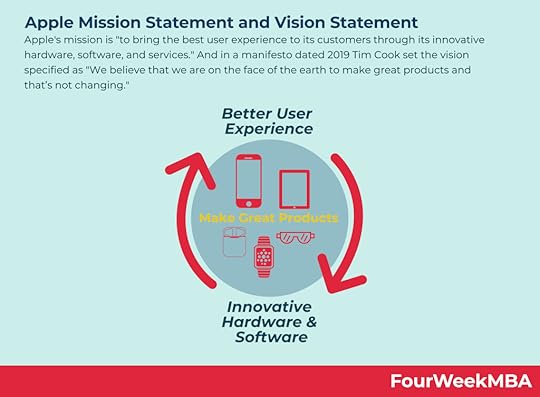 Apple’s mission is “to bring the best user experience to its customers through its innovative hardware, software, and services.” And in a manifesto dated 2019 Tim Cook set the vision specified as “We believe that we are on the face of the earth to make great products and that’s not changing.”
Apple’s mission is “to bring the best user experience to its customers through its innovative hardware, software, and services.” And in a manifesto dated 2019 Tim Cook set the vision specified as “We believe that we are on the face of the earth to make great products and that’s not changing.”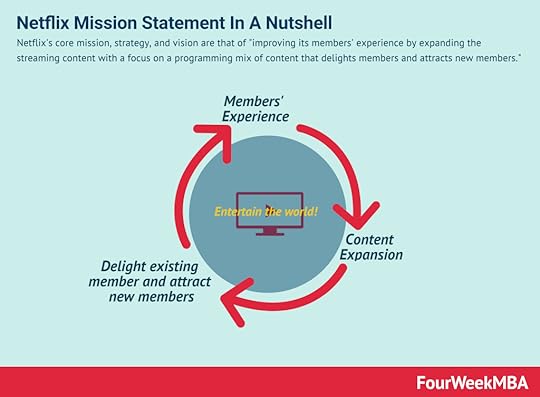 Netflix’s core mission, strategy, and vision are that of “improving its members’ experience by expanding the streaming content with a focus on a programming mix of content that delights members and attracts new members.”
Netflix’s core mission, strategy, and vision are that of “improving its members’ experience by expanding the streaming content with a focus on a programming mix of content that delights members and attracts new members.”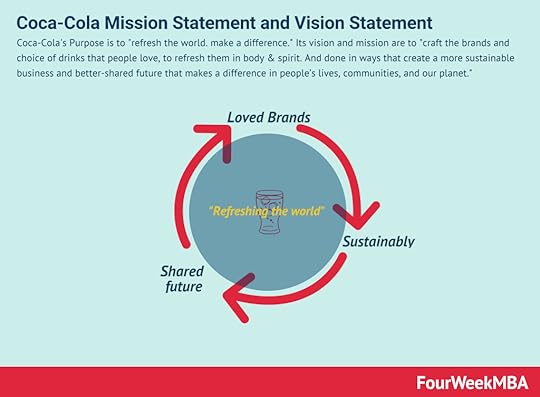 Coca-Cola’s Purpose is to “refresh the world. make a difference.” Its vision and mission are to “craft the brands and choice of drinks that people love, to refresh them in body & spirit. And done in ways that create a more sustainable business and better-shared future that makes a difference in people’s lives, communities, and our planet.”
Coca-Cola’s Purpose is to “refresh the world. make a difference.” Its vision and mission are to “craft the brands and choice of drinks that people love, to refresh them in body & spirit. And done in ways that create a more sustainable business and better-shared future that makes a difference in people’s lives, communities, and our planet.”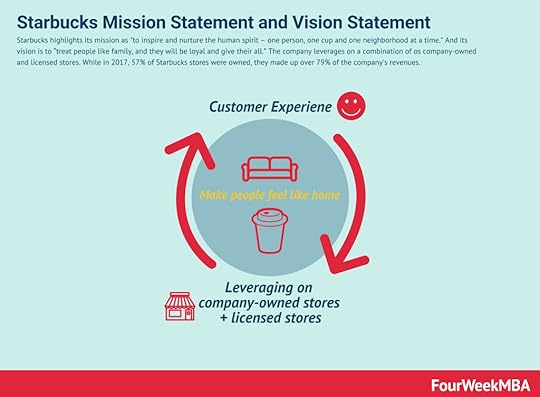 Starbucks highlights its mission as “to inspire and nurture the human spirit – one person, one cup and one neighborhood at a time.” And its vision is to “treat people like family, and they will be loyal and give their all.”
Starbucks highlights its mission as “to inspire and nurture the human spirit – one person, one cup and one neighborhood at a time.” And its vision is to “treat people like family, and they will be loyal and give their all.” 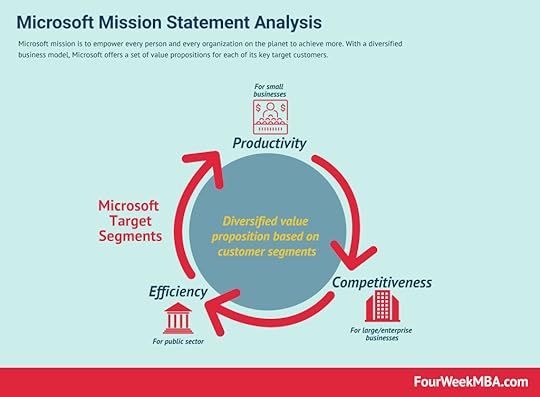 Microsoft’s mission is to empower every person and every organization on the planet to achieve more. With over $110 billion in revenues in 2018, Office Products and Windows are still the main products. Yet the company also operates in Gaming (Xbox), Search Advertising (Bing), Hardware, LinkedIn, Cloud, and more.
Microsoft’s mission is to empower every person and every organization on the planet to achieve more. With over $110 billion in revenues in 2018, Office Products and Windows are still the main products. Yet the company also operates in Gaming (Xbox), Search Advertising (Bing), Hardware, LinkedIn, Cloud, and more. Walmart’smission can be summarized as “helping people around the world save money and live better – anytime and anywhere – in retail stores and through eCommerce.” While its vision is to “make every day easier for busy families.” Walmart defines “busy families” as the bull’s eye of its business strategy.
Walmart’smission can be summarized as “helping people around the world save money and live better – anytime and anywhere – in retail stores and through eCommerce.” While its vision is to “make every day easier for busy families.” Walmart defines “busy families” as the bull’s eye of its business strategy.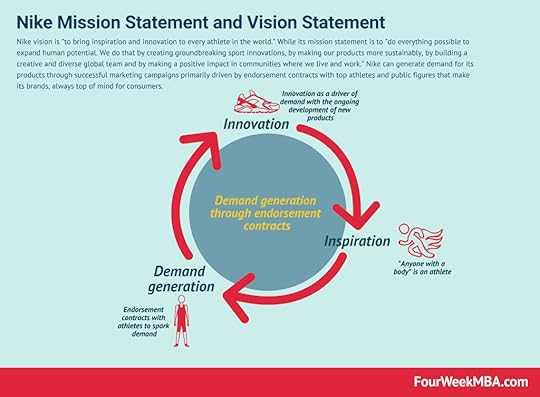 Nike vision is “to bring inspiration and innovation to every athlete in the world.” While its mission statement is to “do everything possible to expand human potential. We do that by creating groundbreaking sport innovations, by making our products more sustainably, by building a creative and diverse global team and by making a positive impact in communities where we live and work.”
Nike vision is “to bring inspiration and innovation to every athlete in the world.” While its mission statement is to “do everything possible to expand human potential. We do that by creating groundbreaking sport innovations, by making our products more sustainably, by building a creative and diverse global team and by making a positive impact in communities where we live and work.”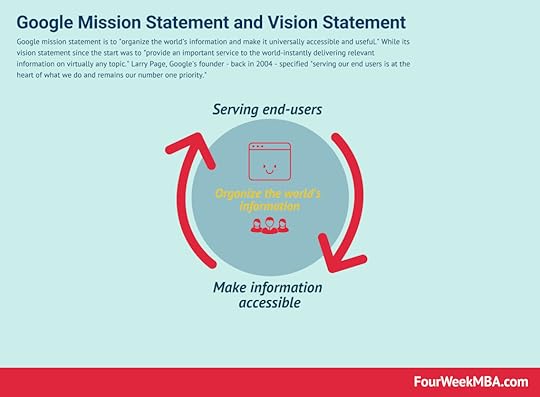 Google mission statement is to “organize the world’s information and make it universally accessible and useful.” Its vision statement is to “provide an important service to the world-instantly delivering relevant information on virtually any topic.” In 2019, Sundar Pichai emphasized a renewed mission to allow people “to get things done!”
Google mission statement is to “organize the world’s information and make it universally accessible and useful.” Its vision statement is to “provide an important service to the world-instantly delivering relevant information on virtually any topic.” In 2019, Sundar Pichai emphasized a renewed mission to allow people “to get things done!”Main Free Guides:
Business ModelsBusiness CompetitionBusiness StrategyBusiness DevelopmentDigital Business ModelsDistribution ChannelsMarketing StrategyPlatform Business ModelsRevenue ModelsTech Business ModelsBlockchain Business Models FrameworkThe post Slack Mission Statement Analysis appeared first on FourWeekMBA.
Lyft Mission Statement Analysis
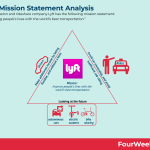
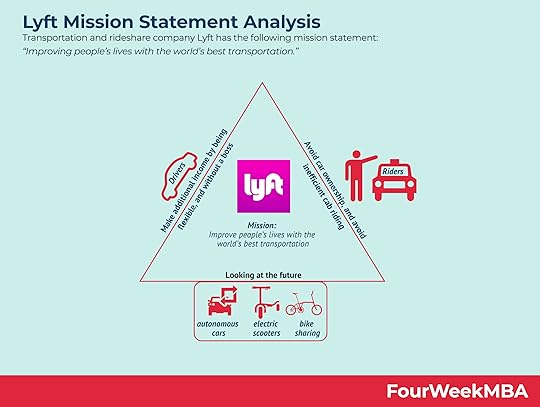
Transportation and rideshare company Lyft has the following mission statement: “Improving people’s lives with the world’s best transportation.”
The LyftUp initiativeOne of the most obvious ways Lyft supports its mission statement is via the LyftUp initiative, a program that seeks to provide transportation for millions of people whose lack of mobility prevents them from accessing basic needs.
To solve this problem, LyftUp wants to provide affordable and accessible transportation for everyone irrespective of their income, age, or postal code.
Some of the company’s specific programs revolve around:
Getting people to workSometimes, the difference between landing a job and a lost opportunity is the ability to show up for an interview.
Lyft provides free car rides to interviews, training programs, and the first three weeks of employment to improve the lives of customers and give job seekers a better chance at success.
Healthy food accessibilityAround 23.5 million people in the United States alone are without access to fresh, healthy food.
In response, Lyft provides discounted trips for low-income families and seniors so they can access grocery stores, food pantries, farmers’ markets, and SNAP (nutrition assistance benefits) appointments.
Bike-share accessLyft has also partnered with NBA star Lebron James and his athlete empowerment company Uninterrupted to improve bike-share access.
With over 4.5 million young Americans unable to access affordable transportation, the program provides free, 12-month bike-share memberships to eligible 16 to 20-year-olds.
Vaccine accessWhile the worst of the pandemic is likely behind us, Lyft still assists those who have trouble attending vaccination appointments.
Customers who require transportation can request a free or discounted ride.
Alternatively, Lyft users can fund rides for others by donating to the company’s non-profit partners who serve low-income and vaccine-hesitant groups.
Lyft City WorksLyft City Works is a program that endeavors to rebuild cities around people to make mobility more seamless, sustainable, connected, and accessible.
To fund this initiative, Lyft invests $50 million or 1% of its profits (whichever is larger) on an annual basis.
The first city to benefit from the scheme was Los Angeles where three priorities were identified: providing transportation, developing transportation infrastructure, and fostering a clean energy future.
Lyft also partnered with Los Angeles Mayor Garcetti’s A Bridge Home program to provide transportation for the city’s substantial homeless population.
WAV ridesLyft also improves people’s lives with its wheelchair-accessible vehicle (WAV) option for those with a disability.
When a user books a WAV ride, they are paired with drivers whose vehicles can accommodate non-folding or motorized wheelchairs and scooters.
These so-called “Access” rides are only available in ten cities across the US and Canada, but the company has plans to expand the service soon.
Key takeaways:Transportation and rideshare company Lyft has the following mission statement: “Improving people’s lives with the world’s best transportation.”Lyft’s mission statement is supported by numerous initiatives and programs that improve the quality of life for its customers. The LyftUp initiative, for example, improves healthy food accessibility and ensures people can make their job interviews and become employed.Other ways the company supports its mission statement include subsidized rides for vaccination appointments, a specialized service for disabled persons, and the Lyft City Works program to make cities more people centric.Read Next: Lyft Business Model
Read: Mission Statement Examples.
Mission Statement Case Studies Adidas’ mission is “To be the best sports brand in the world.” Adidas AG is a German multinational initially founded in 1924 by Adolf Dassler who developed spiked running shoes out of his mother’s house. Today, the company is the largest sportswear producer in Europe and the second largest globally behind rival Nike.
Adidas’ mission is “To be the best sports brand in the world.” Adidas AG is a German multinational initially founded in 1924 by Adolf Dassler who developed spiked running shoes out of his mother’s house. Today, the company is the largest sportswear producer in Europe and the second largest globally behind rival Nike. Uber’s mission statement is to ignite opportunity by setting the world in motion.
Uber’s mission statement is to ignite opportunity by setting the world in motion. Tesla’s vision is to “create the most compelling car company of the 21st century by driving the world’s transition to electric vehicles,” while its mission is “to accelerate the advent of sustainable transport by bringing compelling mass-market electric cars to market as soon as possible.” Tesla used a transitional business model as its ecosystem grows.
Tesla’s vision is to “create the most compelling car company of the 21st century by driving the world’s transition to electric vehicles,” while its mission is “to accelerate the advent of sustainable transport by bringing compelling mass-market electric cars to market as soon as possible.” Tesla used a transitional business model as its ecosystem grows. Amazon’s mission statement is to “serve consumers through online and physical stores and focus on selection, price, and convenience.” Amazon’s vision statement is “to be Earth’s most customer-centric company, where customers can find and discover anything they might want to buy online, and endeavors to offer its customers the lowest possible prices.”
Amazon’s mission statement is to “serve consumers through online and physical stores and focus on selection, price, and convenience.” Amazon’s vision statement is “to be Earth’s most customer-centric company, where customers can find and discover anything they might want to buy online, and endeavors to offer its customers the lowest possible prices.”  Apple’s mission is “to bring the best user experience to its customers through its innovative hardware, software, and services.” And in a manifesto dated 2019 Tim Cook set the vision specified as “We believe that we are on the face of the earth to make great products and that’s not changing.”
Apple’s mission is “to bring the best user experience to its customers through its innovative hardware, software, and services.” And in a manifesto dated 2019 Tim Cook set the vision specified as “We believe that we are on the face of the earth to make great products and that’s not changing.” Netflix’s core mission, strategy, and vision are that of “improving its members’ experience by expanding the streaming content with a focus on a programming mix of content that delights members and attracts new members.”
Netflix’s core mission, strategy, and vision are that of “improving its members’ experience by expanding the streaming content with a focus on a programming mix of content that delights members and attracts new members.” Coca-Cola’s Purpose is to “refresh the world. make a difference.” Its vision and mission are to “craft the brands and choice of drinks that people love, to refresh them in body & spirit. And done in ways that create a more sustainable business and better-shared future that makes a difference in people’s lives, communities, and our planet.”
Coca-Cola’s Purpose is to “refresh the world. make a difference.” Its vision and mission are to “craft the brands and choice of drinks that people love, to refresh them in body & spirit. And done in ways that create a more sustainable business and better-shared future that makes a difference in people’s lives, communities, and our planet.” Starbucks highlights its mission as “to inspire and nurture the human spirit – one person, one cup and one neighborhood at a time.” And its vision is to “treat people like family, and they will be loyal and give their all.”
Starbucks highlights its mission as “to inspire and nurture the human spirit – one person, one cup and one neighborhood at a time.” And its vision is to “treat people like family, and they will be loyal and give their all.”  Microsoft’s mission is to empower every person and every organization on the planet to achieve more. With over $110 billion in revenues in 2018, Office Products and Windows are still the main products. Yet the company also operates in Gaming (Xbox), Search Advertising (Bing), Hardware, LinkedIn, Cloud, and more.
Microsoft’s mission is to empower every person and every organization on the planet to achieve more. With over $110 billion in revenues in 2018, Office Products and Windows are still the main products. Yet the company also operates in Gaming (Xbox), Search Advertising (Bing), Hardware, LinkedIn, Cloud, and more. Walmart’smission can be summarized as “helping people around the world save money and live better – anytime and anywhere – in retail stores and through eCommerce.” While its vision is to “make every day easier for busy families.” Walmart defines “busy families” as the bull’s eye of its business strategy.
Walmart’smission can be summarized as “helping people around the world save money and live better – anytime and anywhere – in retail stores and through eCommerce.” While its vision is to “make every day easier for busy families.” Walmart defines “busy families” as the bull’s eye of its business strategy. Nike vision is “to bring inspiration and innovation to every athlete in the world.” While its mission statement is to “do everything possible to expand human potential. We do that by creating groundbreaking sport innovations, by making our products more sustainably, by building a creative and diverse global team and by making a positive impact in communities where we live and work.”
Nike vision is “to bring inspiration and innovation to every athlete in the world.” While its mission statement is to “do everything possible to expand human potential. We do that by creating groundbreaking sport innovations, by making our products more sustainably, by building a creative and diverse global team and by making a positive impact in communities where we live and work.” Google mission statement is to “organize the world’s information and make it universally accessible and useful.” Its vision statement is to “provide an important service to the world-instantly delivering relevant information on virtually any topic.” In 2019, Sundar Pichai emphasized a renewed mission to allow people “to get things done!”
Google mission statement is to “organize the world’s information and make it universally accessible and useful.” Its vision statement is to “provide an important service to the world-instantly delivering relevant information on virtually any topic.” In 2019, Sundar Pichai emphasized a renewed mission to allow people “to get things done!”Main Free Guides:
Business ModelsBusiness CompetitionBusiness StrategyBusiness DevelopmentDigital Business ModelsDistribution ChannelsMarketing StrategyPlatform Business ModelsRevenue ModelsTech Business ModelsBlockchain Business Models FrameworkThe post Lyft Mission Statement Analysis appeared first on FourWeekMBA.
Salesforce Acquisitions
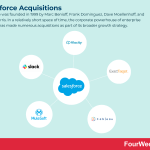
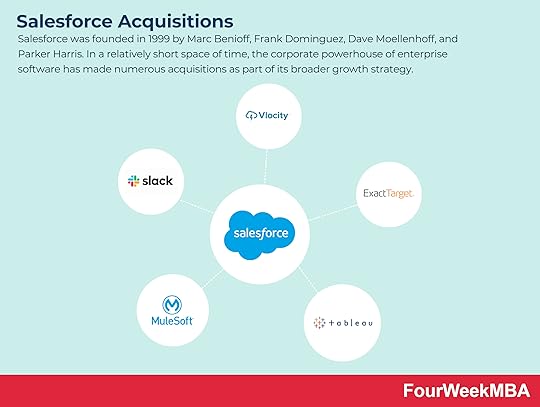
Salesforce was founded in 1999 by Marc Benioff, Frank Dominguez, Dave Moellenhoff, and Parker Harris. In a relatively short space of time, the corporate powerhouse of enterprise software has made numerous acquisitions as part of its broader growth strategy.
So who are these companies? Let’s take a look at a few of them below.
Slack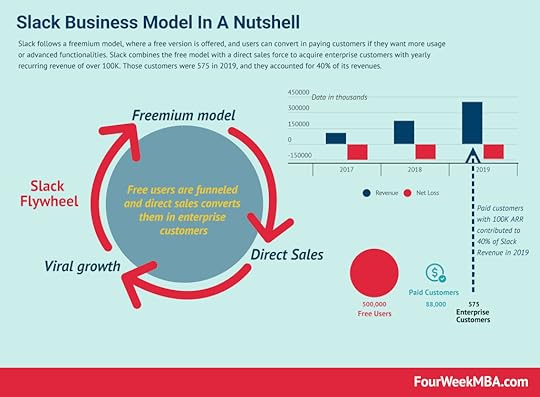 Slack follows a freemium model, where a free version is offered, and users can convert in paying customers if they want more usage or advanced functionalities. Slack combines the free model with a direct sales force to acquire enterprise customers with yearly recurring revenue of over 100K. Those customers were 575 in 2019, and they accounted for 40% of its revenues.
Slack follows a freemium model, where a free version is offered, and users can convert in paying customers if they want more usage or advanced functionalities. Slack combines the free model with a direct sales force to acquire enterprise customers with yearly recurring revenue of over 100K. Those customers were 575 in 2019, and they accounted for 40% of its revenues. At $27.7 billion, Slack is the company’s largest acquisition.
As part of the deal, Slack’s messaging app would be incorporated into the Salesforce enterprise software without any change in the former’s branding, leadership, or functionality.
The Slack purchase also enabled Salesforce to further the remote working trend and create a powerful platform for the work anywhere, digital-first world.
MuleSoftSalesforce’s acquisition of MuleSoft in 2018 for $6.5 billion gave it access to the company’s large customer base and beneficial technology.
By incorporating MuleSoft’s integrative features, Salesforce could become a market leader since its functionality could more easily be incorporated into existing business systems.
One such feature was an API platform/library known as Anypoint that does not require custom integration code.
MuleSoft’s client list was also impressive, including corporate clients such as eBay, Netflix, Wells Fargo, Barclays, Coca-Cola, and Target.
TableauEnterprise data platform Tableau was purchased by Salesforce for $15.7 billion in June 2019, the second largest in the company’s history.
Many pundits considered the move to be a key component of Salesforce’s strategy to obtain a 360-degree view of the customer and become an enterprise data stack.
Prior to the deal, more than 86,000 organizations used Tableau’s visual analytics platform to view their data and use it to solve problems. Some of these included Southwest Airlines, Verizon, Schwab, and Schneider Electric.
ExactTargetExactTarget is a provider of email marketing services that are one-to-one and on-demand.
When Salesforce acquired ExactTarget in 2013 for $2.5 billion, this was seen as a logical step in the company’s expansion into marketing.
Like the purchase of Vlocity – which we’ll explain below – the purchase of ExactTarget furthered SalesForce’s mission to transform how companies connected with their customers via sales, service, and marketing.
VlocityBefore being purchased by Salesforce for $1.33 billion in early 2020, Vlocity had already built six separate CRMs in media and entertainment, insurance and financial services, health, energy and utilities, communications, and government and non-profits.
Some saw the deal coming since Salesforce Ventures was a key investor in the company, but it nevertheless enabled the company to bolster its industry-specific CRM solutions, develop strategic partnerships, and add more functionality to its platform.
ClickSoftwareSalesforce purchased ClickSoftware for around $1.35 billion in 2019, a provider of field service management (FSM) and workforce management software.
The deal, which occurred two months after the one involving Tableau, ostensibly allowed Salesforce to improve its field service products for mobile workforces.
A secondary but no-less-important consideration was ClickSoftware’s 15,400 clients such as Ericsson, Unisys, Bosch, and Deutsche Telekom.
Key takeaways:Salesforce has made a number of significant acquisitions in a relatively short period. The deals involving Tableau and Slack, for example, both exceeded $15 billion.Salesforce acquired email marketer ExactTarget in 2013 and related firm Vlocity in 2020. Both deals enabled Salesforce to bolster its CRM offering and develop strategic industry relationships.Other notable purchases include MuleSoft for $6.5 billion in 2018 and FSM provider ClickSoftware the following year.Read Next: Salesforce Business Model, Slack Business Model
The post Salesforce Acquisitions appeared first on FourWeekMBA.
Target Mission Statement
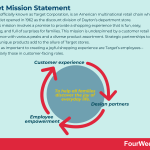
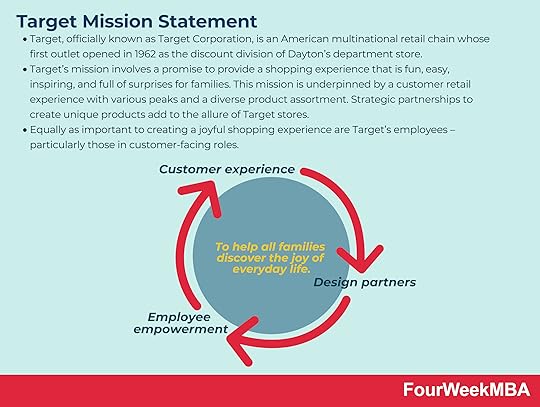
Target, officially known as Target Corporation, is an American multinational retail chain whose first outlet opened in 1962 as the discount division of Dayton’s department store.
Target now employs more than 400,000 employees around the world, and each of them works to carry out the company’s simple but effective mission: “To help all families discover the joy of everyday life.”
Target considers this mission its purpose and promises to provide a shopping experience that is fun, easy, inspiring, and full of surprises.
This idea of making life more joyful also extends to every business decision the company makes and encourages employees to bring a positive attitude to work each day.
With these points in mind, we’ll devote the rest of the article to analyzing Target’s mission statement in the context of customer experience, partnerships, and employee empowerment.
Customer experienceTarget’s brand promise of “Expect More, Pay Less.” is central to its efforts to create a joyful customer experience for families.
The company provides brand-name products at affordable prices and many of the eCommerce-related services consumers expect.
It also strives to offer an unparalleled diversity of products that include high-end products in addition to everyday essentials.
But there are a few services that differentiate Target from the competition. For one, it started to offer discounts on already discounted products in 2013 when it acquired the digital coupon app Cartwheel.
Members of the service, which is now known as Target Circle, have access to hundreds of deals from their favorite brands and can even receive 5% off for purchases made on their birthday.
Target is also known for its private label debit and credit cards which fall under the RedCard product banner. Consumers have access to perks such as free 2-day shipping, 5% off all purchases, and more time to return unwanted products.
Design partnersTo develop products that bring joy and surprise to the consumer, Target has worked with more than 175 design partners over the past 20 years across home décor, food and beverage, electronics, and beauty.
Some of the more notable partners include Levi Strauss, Tabitha Brown, LEGO, and Victoria Beckham.
The partnership with LEGO in 2021 is worth a brief mention, with almost 300 colorful brick-inspired items available for under $30 sold exclusively at Target.
The partnership reflected shared values of joyful optimism and provided consumers with a curated assortment of lifestyle items that could be worn or used to celebrate the holiday season.
Employee empowermentAs a retail company, Target’s employees are the face of its business and are vital to its success.
Target understands that store employees are as important as the products it sells, and also claims that its senior management “know their stuff and know how to have fun.”
In February 2022, Target announced it would be investing up to $300 million to establish a new starting wage range and expand its employee healthcare scheme.
Recognizing the connection between happy and healthy employees and superb customer experience, chief HR officer Melissa Kremer noted that:
“Our team is at the forefront of our strategy and success, and their energy and resilience keeps us at the forefront of meeting the changing needs of our guests year after year.”
Key takeawaysTarget, officially known as Target Corporation, is an American multinational retail chain whose first outlet opened in 1962 as the discount division of Dayton’s department store.Target’s mission involves a promise to provide a shopping experience that is fun, easy, inspiring, and full of surprises for families. This mission is underpinned by a customer retail experience with various peaks and a diverse product assortment. Strategic partnerships to create unique products add to the allure of Target stores.Equally as important to creating a joyful shopping experience are Target’s employees – particularly those in customer-facing roles.Read Also: How To Write A Mission Statement, Mission Statement Examples
Mission Statement Case Studies Adidas’ mission is “To be the best sports brand in the world.” Adidas AG is a German multinational initially founded in 1924 by Adolf Dassler who developed spiked running shoes out of his mother’s house. Today, the company is the largest sportswear producer in Europe and the second largest globally behind rival Nike.
Adidas’ mission is “To be the best sports brand in the world.” Adidas AG is a German multinational initially founded in 1924 by Adolf Dassler who developed spiked running shoes out of his mother’s house. Today, the company is the largest sportswear producer in Europe and the second largest globally behind rival Nike. Uber’s mission statement is to ignite opportunity by setting the world in motion.
Uber’s mission statement is to ignite opportunity by setting the world in motion. Tesla’s vision is to “create the most compelling car company of the 21st century by driving the world’s transition to electric vehicles,” while its mission is “to accelerate the advent of sustainable transport by bringing compelling mass-market electric cars to market as soon as possible.” Tesla used a transitional business model as its ecosystem grows.
Tesla’s vision is to “create the most compelling car company of the 21st century by driving the world’s transition to electric vehicles,” while its mission is “to accelerate the advent of sustainable transport by bringing compelling mass-market electric cars to market as soon as possible.” Tesla used a transitional business model as its ecosystem grows. Amazon’s mission statement is to “serve consumers through online and physical stores and focus on selection, price, and convenience.” Amazon’s vision statement is “to be Earth’s most customer-centric company, where customers can find and discover anything they might want to buy online, and endeavors to offer its customers the lowest possible prices.”
Amazon’s mission statement is to “serve consumers through online and physical stores and focus on selection, price, and convenience.” Amazon’s vision statement is “to be Earth’s most customer-centric company, where customers can find and discover anything they might want to buy online, and endeavors to offer its customers the lowest possible prices.”  Apple’s mission is “to bring the best user experience to its customers through its innovative hardware, software, and services.” And in a manifesto dated 2019 Tim Cook set the vision specified as “We believe that we are on the face of the earth to make great products and that’s not changing.”
Apple’s mission is “to bring the best user experience to its customers through its innovative hardware, software, and services.” And in a manifesto dated 2019 Tim Cook set the vision specified as “We believe that we are on the face of the earth to make great products and that’s not changing.” Netflix’s core mission, strategy, and vision are that of “improving its members’ experience by expanding the streaming content with a focus on a programming mix of content that delights members and attracts new members.”
Netflix’s core mission, strategy, and vision are that of “improving its members’ experience by expanding the streaming content with a focus on a programming mix of content that delights members and attracts new members.” Coca-Cola’s Purpose is to “refresh the world. make a difference.” Its vision and mission are to “craft the brands and choice of drinks that people love, to refresh them in body & spirit. And done in ways that create a more sustainable business and better-shared future that makes a difference in people’s lives, communities, and our planet.”
Coca-Cola’s Purpose is to “refresh the world. make a difference.” Its vision and mission are to “craft the brands and choice of drinks that people love, to refresh them in body & spirit. And done in ways that create a more sustainable business and better-shared future that makes a difference in people’s lives, communities, and our planet.” Starbucks highlights its mission as “to inspire and nurture the human spirit – one person, one cup and one neighborhood at a time.” And its vision is to “treat people like family, and they will be loyal and give their all.”
Starbucks highlights its mission as “to inspire and nurture the human spirit – one person, one cup and one neighborhood at a time.” And its vision is to “treat people like family, and they will be loyal and give their all.”  Microsoft’s mission is to empower every person and every organization on the planet to achieve more. With over $110 billion in revenues in 2018, Office Products and Windows are still the main products. Yet the company also operates in Gaming (Xbox), Search Advertising (Bing), Hardware, LinkedIn, Cloud, and more.
Microsoft’s mission is to empower every person and every organization on the planet to achieve more. With over $110 billion in revenues in 2018, Office Products and Windows are still the main products. Yet the company also operates in Gaming (Xbox), Search Advertising (Bing), Hardware, LinkedIn, Cloud, and more. Walmart’smission can be summarized as “helping people around the world save money and live better – anytime and anywhere – in retail stores and through eCommerce.” While its vision is to “make every day easier for busy families.” Walmart defines “busy families” as the bull’s eye of its business strategy.
Walmart’smission can be summarized as “helping people around the world save money and live better – anytime and anywhere – in retail stores and through eCommerce.” While its vision is to “make every day easier for busy families.” Walmart defines “busy families” as the bull’s eye of its business strategy. Nike vision is “to bring inspiration and innovation to every athlete in the world.” While its mission statement is to “do everything possible to expand human potential. We do that by creating groundbreaking sport innovations, by making our products more sustainably, by building a creative and diverse global team and by making a positive impact in communities where we live and work.”
Nike vision is “to bring inspiration and innovation to every athlete in the world.” While its mission statement is to “do everything possible to expand human potential. We do that by creating groundbreaking sport innovations, by making our products more sustainably, by building a creative and diverse global team and by making a positive impact in communities where we live and work.” Google mission statement is to “organize the world’s information and make it universally accessible and useful.” Its vision statement is to “provide an important service to the world-instantly delivering relevant information on virtually any topic.” In 2019, Sundar Pichai emphasized a renewed mission to allow people “to get things done!”
Google mission statement is to “organize the world’s information and make it universally accessible and useful.” Its vision statement is to “provide an important service to the world-instantly delivering relevant information on virtually any topic.” In 2019, Sundar Pichai emphasized a renewed mission to allow people “to get things done!”The post Target Mission Statement appeared first on FourWeekMBA.
Salesforce Mission Statement
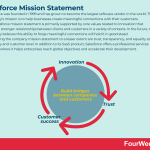
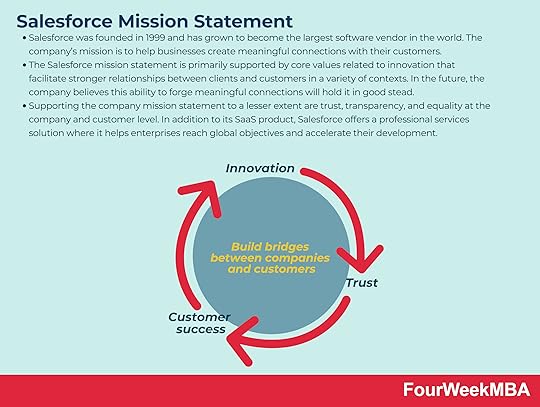
Salesforce’s mission is to build bridges between companies and customers.
Breaking down Salesforce’s mission statementSalesforce was founded in 1999, and over the past two decades, the company has managed to survive the dotcom crash and post 73 straight quarters of revenue growth to become the largest enterprise software firm in the world.
According to its official website, the company’s mission statement reads as follows: “We build bridges between companies and customers. Businesses succeed when they create meaningful connection. Our mission is to deliver it.”
Let’s spend the rest of the article unpacking this statement in the context of some company values that support the Salesforce mission.
InnovationInnovation allows Salesforce to develop technology that builds stronger relationships and changes the world in the process.
These meaningful connections may occur between employees in remote teams, between companies and their clients, or between governments and their citizens.
Ultimately, such connections allow organizations of various shapes and forms to pursue their dreams and solve tricky problems that make the Earth a better place.
In specific terms, connections are built with Customer 360, a scalable CRM platform that provides sales, commerce, IT, service, and marketing teams with a single view of customer data.
After acquiring Tableau in 2019, Salesforce also provides businesses with the opportunity to unearth meaningful insights and better serve customers with data-driven actions.
Salesforce is fully aware that the nature of meaningful connections will change in the future as technology evolves, pivots, and evolves once more.
However, the company believes that its robust customer relationships and ability to innovate will help it navigate the future irrespective of what may transpire.
TrustFor Salesforce, trust is a foundational element of success that starts with transparency.
To that end, the company wants to be transparent about its service performance and availability and strives to safeguard the data of its 150,000 clients in the cloud.
Trust is validated by the numerous compliance certifications and standards the company holds.
These include EU Cloud Code of Conduct, Disaster Recovery & BCP, and APEC Certification for Processors and Controllers, among many others.
Customer successSalesforce understands the direct link between customer success and business success.
The company is proud to note that it delivers more than just technology, with every client provided access to expertise and resources from its product ecosystem.
The company offers three SaaS options – which it calls “Success Plans” – and also a professional services solution where experts can collaborate with forward-thinking enterprises that possess global ambitions.
Ultimately, the latter option was designed to accelerate out-of-the-box implementation and enable businesses to reach their goals faster.
EqualityWhile Salesforce is certainly not the only company to include equality in its core values, it does believe that a diverse workforce is better able to fulfill its mission.
Indeed, the culture that such a workforce creates empowers Salesforce to “innovate, build deeper connections with our customers, and ultimately become a better company.” The company is also committed to driving equality among its customers, with programs in place to provide support for minority business owners and vendors.
Key takeaways:Salesforce was founded in 1999 and has grown to become the largest software vendor in the world. The company’s mission is to help businesses create meaningful connections with their customers.The Salesforce mission statement is primarily supported by core values related to innovation that facilitate stronger relationships between clients and customers in a variety of contexts. In the future, the company believes this ability to forge meaningful connections will hold it in good stead.Supporting the company mission statement to a lesser extent are trust, transparency, and equality at the company and customer level. In addition to its SaaS product, Salesforce offers a professional services solution where it helps enterprises reach global objectives and accelerate their development.Read Next: Salesforce Business Model
Read Also: How To Write A Mission Statement, Mission Statement Examples
Mission Statement Case Studies Adidas’ mission is “To be the best sports brand in the world.” Adidas AG is a German multinational initially founded in 1924 by Adolf Dassler who developed spiked running shoes out of his mother’s house. Today, the company is the largest sportswear producer in Europe and the second largest globally behind rival Nike.
Adidas’ mission is “To be the best sports brand in the world.” Adidas AG is a German multinational initially founded in 1924 by Adolf Dassler who developed spiked running shoes out of his mother’s house. Today, the company is the largest sportswear producer in Europe and the second largest globally behind rival Nike. Uber’s mission statement is to ignite opportunity by setting the world in motion.
Uber’s mission statement is to ignite opportunity by setting the world in motion. Tesla’s vision is to “create the most compelling car company of the 21st century by driving the world’s transition to electric vehicles,” while its mission is “to accelerate the advent of sustainable transport by bringing compelling mass-market electric cars to market as soon as possible.” Tesla used a transitional business model as its ecosystem grows.
Tesla’s vision is to “create the most compelling car company of the 21st century by driving the world’s transition to electric vehicles,” while its mission is “to accelerate the advent of sustainable transport by bringing compelling mass-market electric cars to market as soon as possible.” Tesla used a transitional business model as its ecosystem grows. Amazon’s mission statement is to “serve consumers through online and physical stores and focus on selection, price, and convenience.” Amazon’s vision statement is “to be Earth’s most customer-centric company, where customers can find and discover anything they might want to buy online, and endeavors to offer its customers the lowest possible prices.”
Amazon’s mission statement is to “serve consumers through online and physical stores and focus on selection, price, and convenience.” Amazon’s vision statement is “to be Earth’s most customer-centric company, where customers can find and discover anything they might want to buy online, and endeavors to offer its customers the lowest possible prices.”  Apple’s mission is “to bring the best user experience to its customers through its innovative hardware, software, and services.” And in a manifesto dated 2019 Tim Cook set the vision specified as “We believe that we are on the face of the earth to make great products and that’s not changing.”
Apple’s mission is “to bring the best user experience to its customers through its innovative hardware, software, and services.” And in a manifesto dated 2019 Tim Cook set the vision specified as “We believe that we are on the face of the earth to make great products and that’s not changing.” Netflix’s core mission, strategy, and vision are that of “improving its members’ experience by expanding the streaming content with a focus on a programming mix of content that delights members and attracts new members.”
Netflix’s core mission, strategy, and vision are that of “improving its members’ experience by expanding the streaming content with a focus on a programming mix of content that delights members and attracts new members.” Coca-Cola’s Purpose is to “refresh the world. make a difference.” Its vision and mission are to “craft the brands and choice of drinks that people love, to refresh them in body & spirit. And done in ways that create a more sustainable business and better-shared future that makes a difference in people’s lives, communities, and our planet.”
Coca-Cola’s Purpose is to “refresh the world. make a difference.” Its vision and mission are to “craft the brands and choice of drinks that people love, to refresh them in body & spirit. And done in ways that create a more sustainable business and better-shared future that makes a difference in people’s lives, communities, and our planet.” Starbucks highlights its mission as “to inspire and nurture the human spirit – one person, one cup and one neighborhood at a time.” And its vision is to “treat people like family, and they will be loyal and give their all.”
Starbucks highlights its mission as “to inspire and nurture the human spirit – one person, one cup and one neighborhood at a time.” And its vision is to “treat people like family, and they will be loyal and give their all.”  Microsoft’s mission is to empower every person and every organization on the planet to achieve more. With over $110 billion in revenues in 2018, Office Products and Windows are still the main products. Yet the company also operates in Gaming (Xbox), Search Advertising (Bing), Hardware, LinkedIn, Cloud, and more.
Microsoft’s mission is to empower every person and every organization on the planet to achieve more. With over $110 billion in revenues in 2018, Office Products and Windows are still the main products. Yet the company also operates in Gaming (Xbox), Search Advertising (Bing), Hardware, LinkedIn, Cloud, and more. Walmart’smission can be summarized as “helping people around the world save money and live better – anytime and anywhere – in retail stores and through eCommerce.” While its vision is to “make every day easier for busy families.” Walmart defines “busy families” as the bull’s eye of its business strategy.
Walmart’smission can be summarized as “helping people around the world save money and live better – anytime and anywhere – in retail stores and through eCommerce.” While its vision is to “make every day easier for busy families.” Walmart defines “busy families” as the bull’s eye of its business strategy. Nike vision is “to bring inspiration and innovation to every athlete in the world.” While its mission statement is to “do everything possible to expand human potential. We do that by creating groundbreaking sport innovations, by making our products more sustainably, by building a creative and diverse global team and by making a positive impact in communities where we live and work.”
Nike vision is “to bring inspiration and innovation to every athlete in the world.” While its mission statement is to “do everything possible to expand human potential. We do that by creating groundbreaking sport innovations, by making our products more sustainably, by building a creative and diverse global team and by making a positive impact in communities where we live and work.” Google mission statement is to “organize the world’s information and make it universally accessible and useful.” Its vision statement is to “provide an important service to the world-instantly delivering relevant information on virtually any topic.” In 2019, Sundar Pichai emphasized a renewed mission to allow people “to get things done!”
Google mission statement is to “organize the world’s information and make it universally accessible and useful.” Its vision statement is to “provide an important service to the world-instantly delivering relevant information on virtually any topic.” In 2019, Sundar Pichai emphasized a renewed mission to allow people “to get things done!”The post Salesforce Mission Statement appeared first on FourWeekMBA.
Google Subsidiaries: The List Of Companies Owned By Google [Alphabet]
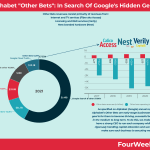
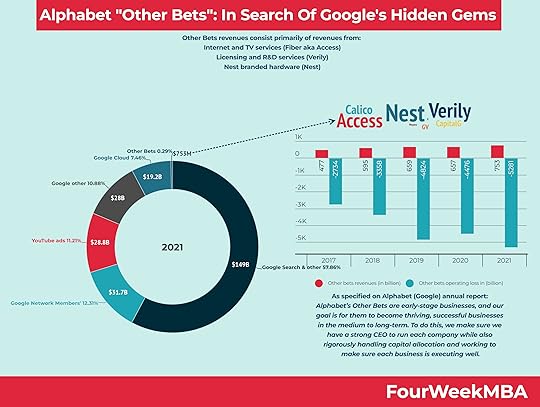
Google’s business model (now Alphabet), started as a search engine to navigate the web, and over the years it acquired other companies like YouTube and Android and it placed other bets on what the company defines as “moonshots.” Among the other bets, there are companies like Verily, Nest, Access, and Waymo.
What makes up Google’s Empire? Related Business Models Case Studies Google (now Alphabet) primarily makes money through advertising. The Google search engine, while free, is monetized with paid advertising. In 2021 Google’s advertising generated over $209 billion (beyond Google Search, which comprises YouTube Ads and the Network Members Sites) compared to $257 billion in net sales. Advertising represented over 81% of net sales, followed by Google Cloud ($19 billion) and Google’s other revenue streams (Google Play, Pixel phones, and YouTube Premium).
Google (now Alphabet) primarily makes money through advertising. The Google search engine, while free, is monetized with paid advertising. In 2021 Google’s advertising generated over $209 billion (beyond Google Search, which comprises YouTube Ads and the Network Members Sites) compared to $257 billion in net sales. Advertising represented over 81% of net sales, followed by Google Cloud ($19 billion) and Google’s other revenue streams (Google Play, Pixel phones, and YouTube Premium). A hidden revenue business model is a pattern for revenue generation that keeps users out of the equation, so they don’t pay for the service or product offered. For instance, Google’s users don’t pay for the search engine. Instead, the revenue streams come from advertising money spent by businesses bidding on keywords.
A hidden revenue business model is a pattern for revenue generation that keeps users out of the equation, so they don’t pay for the service or product offered. For instance, Google’s users don’t pay for the search engine. Instead, the revenue streams come from advertising money spent by businesses bidding on keywords.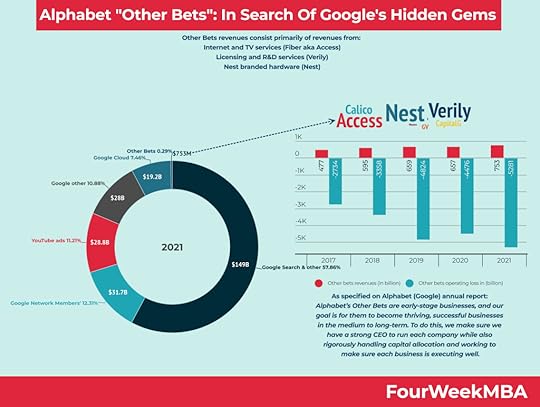 Of Google’s (Alphabet) over $257 billion revenues for 2021, Google also generated $753 million from a group of startup bets, which Google considers potential moonshots (companies that might open up new industries). Those Google’s bets also generated a loss for the company of over $5.2 billion. In short, Google is using the money generated by search and betting it on other innovative industries.
Of Google’s (Alphabet) over $257 billion revenues for 2021, Google also generated $753 million from a group of startup bets, which Google considers potential moonshots (companies that might open up new industries). Those Google’s bets also generated a loss for the company of over $5.2 billion. In short, Google is using the money generated by search and betting it on other innovative industries. Google Organizational Structure
 Google (Alphabet) has a cross-functional (team-based) organizational structure known as a matrix structure with some degree of flatness. Over the years, as the company scaled and it became a tech giant, its organizational structure is morphing more into a centralized organization.
Google (Alphabet) has a cross-functional (team-based) organizational structure known as a matrix structure with some degree of flatness. Over the years, as the company scaled and it became a tech giant, its organizational structure is morphing more into a centralized organization. 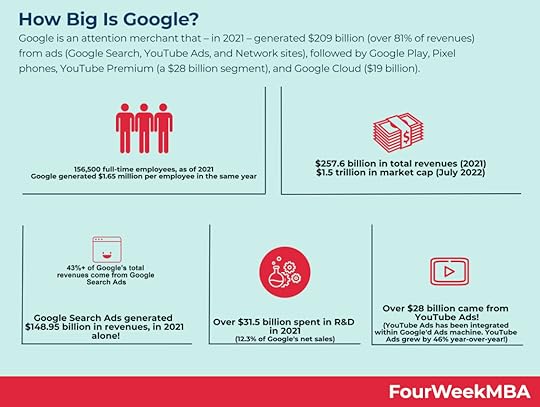 Google is an attention merchant that – in 2021 – generated $209 billion (over 81% of revenue) from ads (Google Search, YouTube Ads, and Network sites), followed by Google Play, Pixel phones, YouTube Premium (a $28 billion segment), and Google Cloud ($19 billion). Over $31.5 billion went toward R&D (12.3% of its revenues).
Google is an attention merchant that – in 2021 – generated $209 billion (over 81% of revenue) from ads (Google Search, YouTube Ads, and Network sites), followed by Google Play, Pixel phones, YouTube Premium (a $28 billion segment), and Google Cloud ($19 billion). Over $31.5 billion went toward R&D (12.3% of its revenues).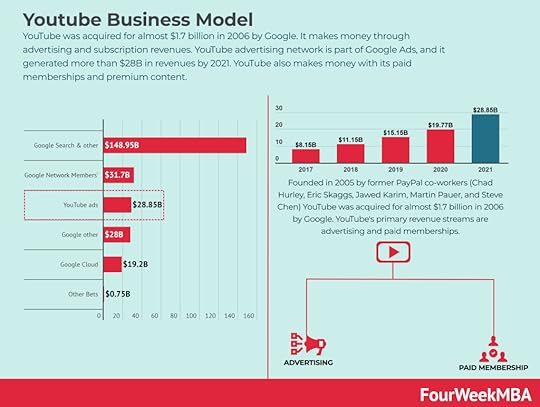 YouTube was acquired for almost $1.7 billion in 2006 by Google. It makes money through advertising and subscription revenues. YouTube advertising network is part of Google Ads, generating more than $28B in revenue by 2021. YouTube also makes money with its paid memberships and premium content.
YouTube was acquired for almost $1.7 billion in 2006 by Google. It makes money through advertising and subscription revenues. YouTube advertising network is part of Google Ads, generating more than $28B in revenue by 2021. YouTube also makes money with its paid memberships and premium content.Google Traffic Acquisition Costs
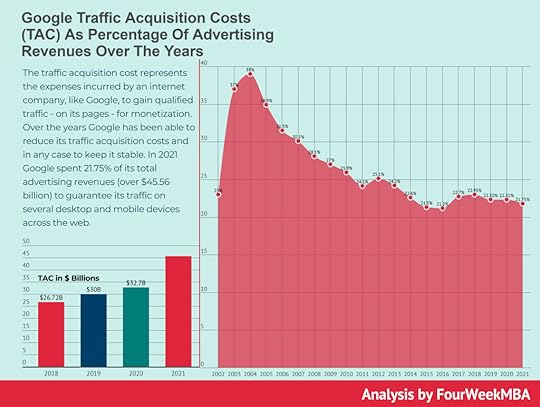 The traffic acquisition cost represents the expenses incurred by an internet company, like Google, to gain qualified traffic – on its pages – for monetization. Over the years, Google has been able to reduce its traffic acquisition costs and, in any case, keep it stable. In 2021 Google spent 21.75% of its total advertising revenues (over $45.56 billion) to guarantee its traffic on several desktop and mobile devices across the web.
The traffic acquisition cost represents the expenses incurred by an internet company, like Google, to gain qualified traffic – on its pages – for monetization. Over the years, Google has been able to reduce its traffic acquisition costs and, in any case, keep it stable. In 2021 Google spent 21.75% of its total advertising revenues (over $45.56 billion) to guarantee its traffic on several desktop and mobile devices across the web.Read Next: Google Business Model, How Does Google Make Money, Google Other Bets, Moonshot Thinking, YouTube Business Model.
Main Free Guides:
Business ModelsBusiness StrategyBusiness DevelopmentDigital Business ModelsDistribution ChannelsMarketing StrategyPlatform Business ModelsRevenue ModelsTech Business ModelsBlockchain Business Models FrameworkThe post Google Subsidiaries: The List Of Companies Owned By Google [Alphabet] appeared first on FourWeekMBA.
October 17, 2022
LinkedIn Mission Statement Analysis
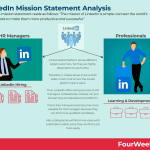
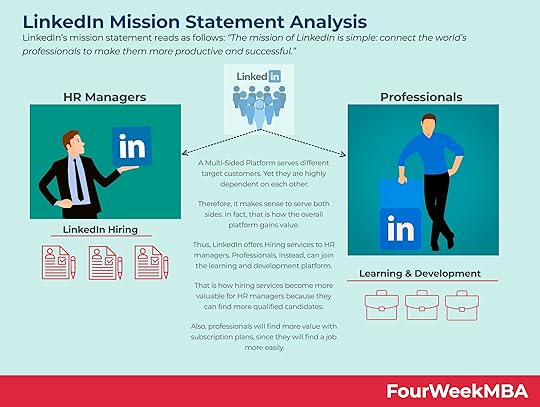
LinkedIn’s mission statement reads as follows: “The mission of LinkedIn is simple: connect the world’s professionals to make them more productive and successful.”
Understanding LinkedIn’s mission statementThere are three main components to LinkedIn’s mission statement: connection, productivity, and success.
We have taken the time to explain each of them in detail below.
ConnectionFrom reading LinkedIn’s mission statement, one can easily appreciate that the platform’s primary purpose is to connect professionals with other professionals.
What’s more, with over 850 million members around the world, it is also easy to appreciate how many connections LinkedIn must facilitate on a daily basis.
LinkedIn is essentially a social networking platform where users can connect with others, apply for positions, search for those with specific credentials, and find information on companies of interest.
The platform shares attributes with other social media sites and LinkedIn users can improve their visibility on the platform by positioning themselves as experts in their industry.
To that end, users can comment on the articles written by others or write their own thought-leadership articles to start a discussion around a pertinent topic.
ProductivityLinkedIn offers numerous learning and development courses for employees or job seekers.
On the LinkedIn Learning Blog, one can find productivity tips on:
How to deliver an engaging and effective remote presentation.How to stay focused throughout the day.How to work in teams.How to communicate with colleagues, andHow to manage stress.The company’s 2022 Skills Bracket Challenge also teaches employees that learning new skills is a key part of resilience and doing one’s best work.
One of the courses mentioned during the challenge was entitled Humane Productivity: Burnout Proof Your Performance.
In the course, creator Rahaf Harfoush reiterates to employees that non-stop hustle does not lead to increased performance.
He also explains that productivity is never about feeling guilty if one is unproductive or wants to take a day off.
SuccessThe aforementioned learning and development courses also play an important role in employee success.
But does employee success enable the company to achieve its mission?
In any given week, around 40 million people are searching for jobs on LinkedIn, with three of these job seekers hired every minute.
Job seekers with a comprehensive LinkedIn profile were also 71% more likely to get a job interview and a recent study found that 35.5 million users have been hired by a person they connected with on the platform.
LinkedIn’s vision statementLinkedIn’s vision statement is to:
“Create economic opportunity for every member of the global workforce.”
In a hint to how important this vision is to the company, former CEO Jeff Weiner once said that:
“creating economic opportunity will be the defining issue of our time. That’s why I’m here and why I can’t imagine doing any other job. Simply put, what we do matters, and matters even more than ever.”
This vision statement is powerful because it is inspirational, supports the mission statement, and creates an emotional attachment to the company’s visualization of the future.
Key takeaways:LinkedIn’s mission statement reads as follows: “The mission of LinkedIn is simple: connect the world’s professionals to make them more productive and successful.”LinkedIn’s mission statement is comprised of three key components: connection, productivity, and success. With over 800 million users and extensive learning and development opportunities, LinkedIn users can improve their productivity, upskill, network with others, or successfully find new employment.LinkedIn’s vision statement is to “Create economic opportunity for every member of the global workforce.” This powerful, emotionally evocative vision supports the realization of the company’s mission.Read Next: LinkedIn Business Model, Microsoft Business Model.
Read: Mission Statement Examples.
Mission Statement Case Studies Adidas’ mission is “To be the best sports brand in the world.” Adidas AG is a German multinational initially founded in 1924 by Adolf Dassler who developed spiked running shoes out of his mother’s house. Today, the company is the largest sportswear producer in Europe and the second largest globally behind rival Nike.
Adidas’ mission is “To be the best sports brand in the world.” Adidas AG is a German multinational initially founded in 1924 by Adolf Dassler who developed spiked running shoes out of his mother’s house. Today, the company is the largest sportswear producer in Europe and the second largest globally behind rival Nike. Uber’s mission statement is to ignite opportunity by setting the world in motion.
Uber’s mission statement is to ignite opportunity by setting the world in motion. Tesla’s vision is to “create the most compelling car company of the 21st century by driving the world’s transition to electric vehicles,” while its mission is “to accelerate the advent of sustainable transport by bringing compelling mass-market electric cars to market as soon as possible.” Tesla used a transitional business model as its ecosystem grows.
Tesla’s vision is to “create the most compelling car company of the 21st century by driving the world’s transition to electric vehicles,” while its mission is “to accelerate the advent of sustainable transport by bringing compelling mass-market electric cars to market as soon as possible.” Tesla used a transitional business model as its ecosystem grows. Amazon’s mission statement is to “serve consumers through online and physical stores and focus on selection, price, and convenience.” Amazon’s vision statement is “to be Earth’s most customer-centric company, where customers can find and discover anything they might want to buy online, and endeavors to offer its customers the lowest possible prices.”
Amazon’s mission statement is to “serve consumers through online and physical stores and focus on selection, price, and convenience.” Amazon’s vision statement is “to be Earth’s most customer-centric company, where customers can find and discover anything they might want to buy online, and endeavors to offer its customers the lowest possible prices.”  Apple’s mission is “to bring the best user experience to its customers through its innovative hardware, software, and services.” And in a manifesto dated 2019 Tim Cook set the vision specified as “We believe that we are on the face of the earth to make great products and that’s not changing.”
Apple’s mission is “to bring the best user experience to its customers through its innovative hardware, software, and services.” And in a manifesto dated 2019 Tim Cook set the vision specified as “We believe that we are on the face of the earth to make great products and that’s not changing.” Netflix’s core mission, strategy, and vision are that of “improving its members’ experience by expanding the streaming content with a focus on a programming mix of content that delights members and attracts new members.”
Netflix’s core mission, strategy, and vision are that of “improving its members’ experience by expanding the streaming content with a focus on a programming mix of content that delights members and attracts new members.” Coca-Cola’s Purpose is to “refresh the world. make a difference.” Its vision and mission are to “craft the brands and choice of drinks that people love, to refresh them in body & spirit. And done in ways that create a more sustainable business and better-shared future that makes a difference in people’s lives, communities, and our planet.”
Coca-Cola’s Purpose is to “refresh the world. make a difference.” Its vision and mission are to “craft the brands and choice of drinks that people love, to refresh them in body & spirit. And done in ways that create a more sustainable business and better-shared future that makes a difference in people’s lives, communities, and our planet.” Starbucks highlights its mission as “to inspire and nurture the human spirit – one person, one cup and one neighborhood at a time.” And its vision is to “treat people like family, and they will be loyal and give their all.”
Starbucks highlights its mission as “to inspire and nurture the human spirit – one person, one cup and one neighborhood at a time.” And its vision is to “treat people like family, and they will be loyal and give their all.”  Microsoft’s mission is to empower every person and every organization on the planet to achieve more. With over $110 billion in revenues in 2018, Office Products and Windows are still the main products. Yet the company also operates in Gaming (Xbox), Search Advertising (Bing), Hardware, LinkedIn, Cloud, and more.
Microsoft’s mission is to empower every person and every organization on the planet to achieve more. With over $110 billion in revenues in 2018, Office Products and Windows are still the main products. Yet the company also operates in Gaming (Xbox), Search Advertising (Bing), Hardware, LinkedIn, Cloud, and more. Walmart’smission can be summarized as “helping people around the world save money and live better – anytime and anywhere – in retail stores and through eCommerce.” While its vision is to “make every day easier for busy families.” Walmart defines “busy families” as the bull’s eye of its business strategy.
Walmart’smission can be summarized as “helping people around the world save money and live better – anytime and anywhere – in retail stores and through eCommerce.” While its vision is to “make every day easier for busy families.” Walmart defines “busy families” as the bull’s eye of its business strategy. Nike vision is “to bring inspiration and innovation to every athlete in the world.” While its mission statement is to “do everything possible to expand human potential. We do that by creating groundbreaking sport innovations, by making our products more sustainably, by building a creative and diverse global team and by making a positive impact in communities where we live and work.”
Nike vision is “to bring inspiration and innovation to every athlete in the world.” While its mission statement is to “do everything possible to expand human potential. We do that by creating groundbreaking sport innovations, by making our products more sustainably, by building a creative and diverse global team and by making a positive impact in communities where we live and work.” Google mission statement is to “organize the world’s information and make it universally accessible and useful.” Its vision statement is to “provide an important service to the world-instantly delivering relevant information on virtually any topic.” In 2019, Sundar Pichai emphasized a renewed mission to allow people “to get things done!”
Google mission statement is to “organize the world’s information and make it universally accessible and useful.” Its vision statement is to “provide an important service to the world-instantly delivering relevant information on virtually any topic.” In 2019, Sundar Pichai emphasized a renewed mission to allow people “to get things done!”Main Free Guides:
Business ModelsBusiness CompetitionBusiness StrategyBusiness DevelopmentDigital Business ModelsDistribution ChannelsMarketing StrategyPlatform Business ModelsRevenue ModelsTech Business ModelsBlockchain Business Models FrameworkThe post LinkedIn Mission Statement Analysis appeared first on FourWeekMBA.
Zepto Business Model
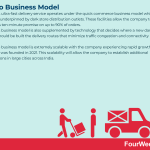

Zepto’s ultra-fast delivery service operates under the quick commerce business model which itself is underpinned by dark store distribution centers.
Understanding Zepto’s business modelZepto is an Indian-based platform that promises to deliver groceries in under ten minutes.
The company was founded by Aadit Palicha and Kaivalya Vohra in 2021 and has recently secured a Y-Combinator-led funding round worth $200 million.
Zepto’s fast delivery business model is supported by a network of over 100 dark stores and micro fulfillment centers.
These facilities, which allow the company to fulfill its ten-minute promise on up to 90% of orders, possess the following characteristics:
They are not open to the public.They are located in high-demand neighborhoods.They stock only the most commonly ordered items.They are ergonomically designed to ensure order packers can move as swiftly and efficiently as possible.Zepto’s business model is also supplemented by technology that determines where a dark store should be built and optimal delivery routes that avoid traffic and connectivity issues.
Technology is also used to improve delivery network performance by considering factors such as weather, road patterns, population, geography, and last-mile supply availability.
Like most other quick commerce companies, Zepto is also focused on increasing order frequency to drive better economics.
In the Indian market where it operates, many of the company’s regular customers make three to four orders per week with an average order volume of 400-500 Indian rupees.
Zepto growth and scalabilityZepto is currently available in ten Indian cities.
The company plans to use its latest round of investment funding to expand and compete with established competitors such as Dunzo, Zomato, Amazon, and Flipkart.
Zepto also plans to recruit across various functions such as HR, finance, and operations and extend its team which already numbers over 1,000.
While the company’s founders are reticent to share financial data, Zepto recently posted 800% quarter-over-quarter growth with an impressive net promoter score (NPS) of 88.
In a May 2022 interview with Business Standard, Palicha explained that
“Our rigorous focus on unit economics is the main reason why we’ve had such an amazing trajectory as a company. We’ve turned micro-markets profitable and brought down burn significantly while growing to a scale of hundreds of thousands of orders per day.”
Moving forward, Zepto has plans to rapidly scale its business model across India to take advantage of densely populated areas and a COVID-accelerated trend toward quick commerce.
This will allow the company to secure a slice of the $570 billion grocery retail industry in India.
Key takeaways:Zepto’s ultra-fast delivery service operates under the quick commerce business model which itself is underpinned by dark store distribution outlets. These facilities allow the company to fulfill its ten-minute promise on up to 90% of orders.Zepto’s business model is also supplemented by technology that decides where a new dark store should be built the delivery routes that minimize traffic congestion and connectivity issues.Zepto’s business model is extremely scalable with the company experiencing rapid growth since it was founded in 2021. This scalability will allow the company to establish additional operations in large cities across India.Connected Last-Mile Delivery Business Models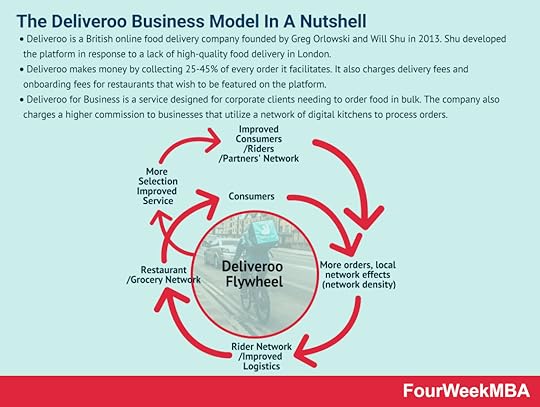 Deliveroo is a British online food delivery company founded by Greg Orlowski and Will Shu in 2013. Shu developed the platform in response to a lack of high-quality food delivery in London.Deliveroo makes money by collecting 25-45% of every order it facilitates. It also charges delivery fees and onboarding fees for restaurants that wish to be featured on the platform.Deliveroo for Business is a service designed for corporate clients needing to order food in bulk. The company also charges a higher commission to businesses that utilize a network of digital kitchens to process orders.
Deliveroo is a British online food delivery company founded by Greg Orlowski and Will Shu in 2013. Shu developed the platform in response to a lack of high-quality food delivery in London.Deliveroo makes money by collecting 25-45% of every order it facilitates. It also charges delivery fees and onboarding fees for restaurants that wish to be featured on the platform.Deliveroo for Business is a service designed for corporate clients needing to order food in bulk. The company also charges a higher commission to businesses that utilize a network of digital kitchens to process orders.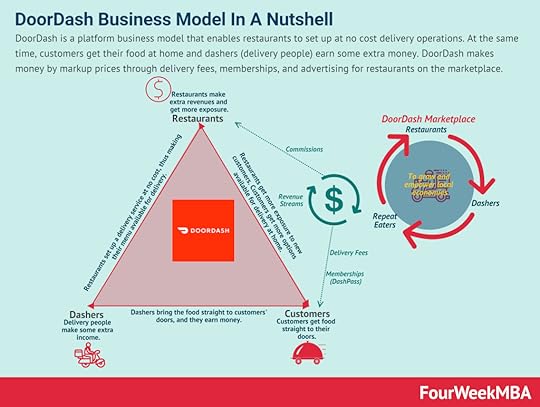 DoorDash is a platform business model that enables restaurants to set up at-no-cost delivery operations. At the same time, customers get their food at home, and dashers (delivery people) earn some extra money. DoorDash makes money by markup prices through delivery fees, memberships, and advertising for restaurants on the marketplace.
DoorDash is a platform business model that enables restaurants to set up at-no-cost delivery operations. At the same time, customers get their food at home, and dashers (delivery people) earn some extra money. DoorDash makes money by markup prices through delivery fees, memberships, and advertising for restaurants on the marketplace.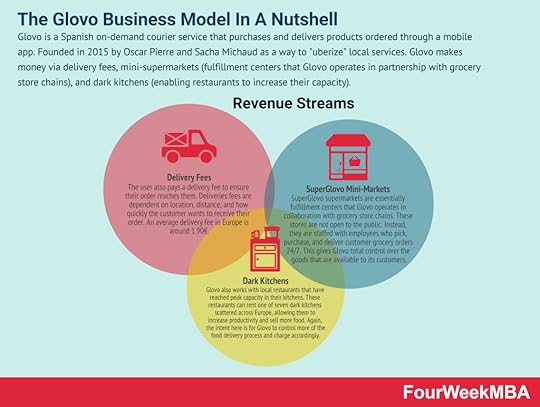 Glovo is a Spanish on-demand courier service that purchases and delivers products ordered through a mobile app. Founded in 2015 by Oscar Pierre and Sacha Michaud as a way to “uberize” local services. Glovo makes money via delivery fees, mini-supermarkets (fulfillment centers that Glovo operates in partnership with grocery store chains), and dark kitchens (enabling restaurants to increase their capacity).
Glovo is a Spanish on-demand courier service that purchases and delivers products ordered through a mobile app. Founded in 2015 by Oscar Pierre and Sacha Michaud as a way to “uberize” local services. Glovo makes money via delivery fees, mini-supermarkets (fulfillment centers that Glovo operates in partnership with grocery store chains), and dark kitchens (enabling restaurants to increase their capacity).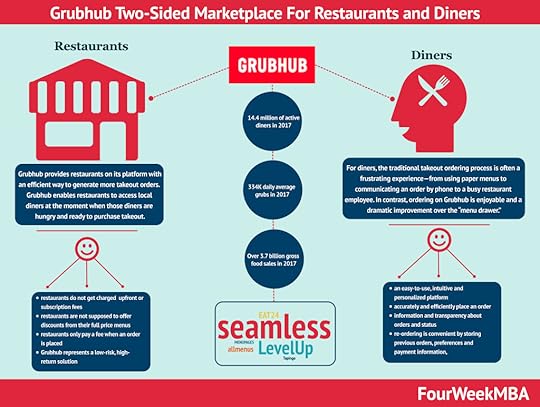 Grubhub is an online and mobile platform for restaurant pick-up and delivery orders. In 2018 the company connected 95,000 takeout restaurants in over 1,700 U.S. cities and London. The Grubhub portfolio of brands like Seamless, LevelUp, Eat24, AllMenus, MenuPages, and Tapingo. The company makes money primarily by charging restaurants a pre-order commission, and it generates revenues when diners place an order on its platform. Also, it charges restaurants that use Grubhub delivery services when diners pay for them.
Grubhub is an online and mobile platform for restaurant pick-up and delivery orders. In 2018 the company connected 95,000 takeout restaurants in over 1,700 U.S. cities and London. The Grubhub portfolio of brands like Seamless, LevelUp, Eat24, AllMenus, MenuPages, and Tapingo. The company makes money primarily by charging restaurants a pre-order commission, and it generates revenues when diners place an order on its platform. Also, it charges restaurants that use Grubhub delivery services when diners pay for them. 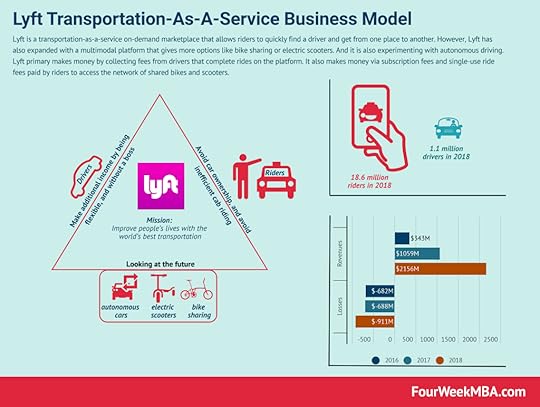 Lyft is a transportation-as-a-service marketplace allowing riders to find a driver for a ride. Lyft has also expanded with a multimodal platform that gives more options like bike-sharing or electric scooters. Lyft primarily makes money by collecting fees from drivers that complete rides on the platform.
Lyft is a transportation-as-a-service marketplace allowing riders to find a driver for a ride. Lyft has also expanded with a multimodal platform that gives more options like bike-sharing or electric scooters. Lyft primarily makes money by collecting fees from drivers that complete rides on the platform.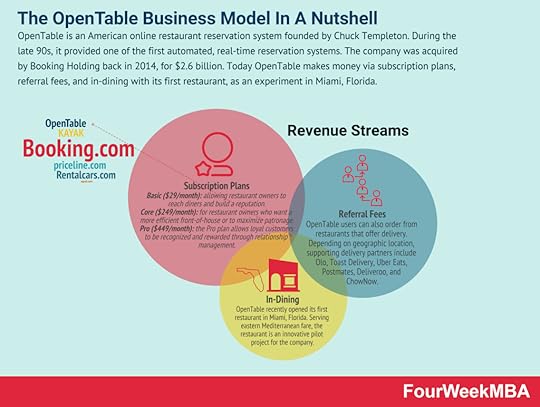 OpenTable is an American online restaurant reservation system founded by Chuck Templeton. During the late 90s, it provided one of the first automated, real-time reservation systems. The company was acquired by Booking Holding back in 2014 for $2.6 billion. Today OpenTable makes money via subscription plans, referral fees, and in-dining with its first restaurant, as an experiment in Miami, Florida.
OpenTable is an American online restaurant reservation system founded by Chuck Templeton. During the late 90s, it provided one of the first automated, real-time reservation systems. The company was acquired by Booking Holding back in 2014 for $2.6 billion. Today OpenTable makes money via subscription plans, referral fees, and in-dining with its first restaurant, as an experiment in Miami, Florida. 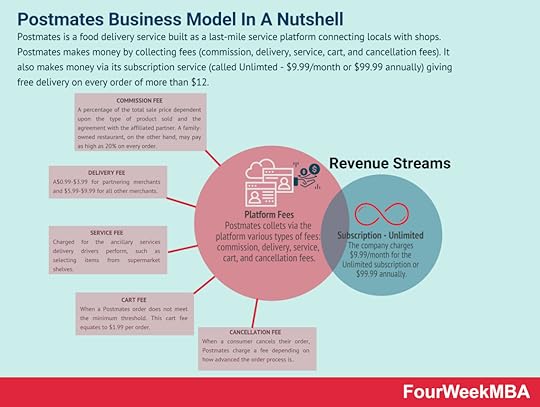 Postmates is a food delivery service built as a last-mile delivery service platform connecting locals with shops. Postmates makes money by collecting fees (commission, delivery, service, cart, and cancellation fees). It also makes money via its subscription service (called Unlimted – $9.99/month or $99.99 annually), giving free delivery on orders of more than $12.
Postmates is a food delivery service built as a last-mile delivery service platform connecting locals with shops. Postmates makes money by collecting fees (commission, delivery, service, cart, and cancellation fees). It also makes money via its subscription service (called Unlimted – $9.99/month or $99.99 annually), giving free delivery on orders of more than $12. Uber Eats is a three-sided marketplace connecting a driver, a restaurant owner, and a customer with Uber Eats platform at the center. The three-sided marketplace moves around three players: Restaurants pay commission on the orders to Uber Eats; Customers pay small delivery charges and, at times, cancellation fees; Drivers earn through making reliable deliveries on time.
Uber Eats is a three-sided marketplace connecting a driver, a restaurant owner, and a customer with Uber Eats platform at the center. The three-sided marketplace moves around three players: Restaurants pay commission on the orders to Uber Eats; Customers pay small delivery charges and, at times, cancellation fees; Drivers earn through making reliable deliveries on time.Main Free Guides:
Business ModelsBusiness StrategyBusiness DevelopmentDigital Business ModelsDistribution ChannelsMarketing StrategyPlatform Business ModelsTech Business ModelThe post Zepto Business Model appeared first on FourWeekMBA.



